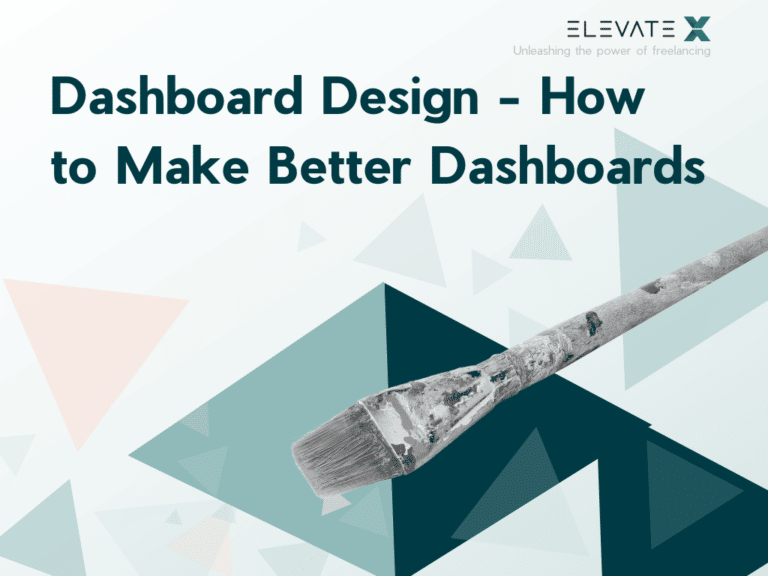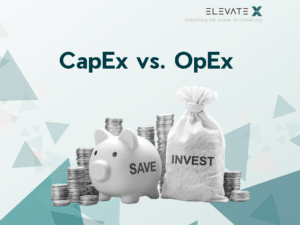This article was was originally published here.
Dashboards play a fundamental role in many businesses, nowadays. The ability to collect and analyze user data has transformed the way companies understand customer behavior and provide better value propositions. Too often, the way the data is presented fails to communicate information effectively though. Let’s fix that!
What Is a Dashboard? — First Things First
At the most fundamental level, a dashboard is a screen that contains relevant data about a specific purpose. It gives insights into a business’s performance by displaying KPIs, metrics, and data points. A dashboard is often used to evaluate those data to optimize a business, a business unit, or a channel and plan ahead.
“A dashboard is a visual display of the most important information needed to achieve one or more objectives; consolidated and arranged on a single screen so the information can be monitored at a glance.”
– Stephen Few, Rich Data Poor Data
KEY POINTS
- A Dashboard is a screen that summarizes all relevant data.
- It got his name from automobile dashboards.
- The most common types are strategic, operational and analytical dashboards.
- Be aware of what your goal is and what end user you want to serve.
Did You Know Where Dashboards Got Their Name From?
The dashboard inherits its name from automobile dashboards, which provide the driver with all the necessary information that is needed to drive the car safely. It also serves as an analogy to what must be shown on a dashboard. Think about it: We don’t need a car dashboard to display unnecessary details like the wind direction, air pressure, or news. As a matter of fact, this would actually be counterproductive.
What Should Be Shown in a Dashboard?
Dashboards should be able to summarize relevant data to help decision-makers make more informed decisions. This does not mean stuffing the dashboard with as much data as you can. It means quite the opposite: Cut out unnecessary data that doesn’t help with the decision-making process.
“Perfection is achieved, not when there is nothing more to add, but when there is nothing left to take away.”
– Antoine de Saint-Exupery
Before designing your dashboard, you should be aware of what are you trying to achieve with the dashboard. In addition, you should define the scope of your dashboard. In most businesses or departments, it won’t help you collect all the data points at your hands and throw them onto your dashboard. Therefore, you have to decide whether you want the dashboard to focus on high-level, aggregate data, or on more granular, low-level data. It goes without saying, that the goal complements the scope and vice-versa.
The most important aspect of a dashboard is that it should answer your questions and monitor whatever you want to measure — all within the range of the eye.
Dashboard vs. Report — Some Important Differences
- Reports are static, and dashboards are interactive and can be live.
Reports contain static data in the form of text or tabular data. Modern dashboards are often interactive which means they either provide live data or you can adjust the dashboard to show specific data. For example, a specific date range or data filters. - Reports are longer and more detailed than dashboards.
Reports contain more information. Not only regarding the amount of detail but also visually. Think of the dashboard as a screen where all data is fit. And a report as a scrollable document where several screens fit in. Or, as Stephen Few, a world leader in data visualization puts it: “My insistence that a dashboard should confine its display to a single screen with no need for scrolling or switching among multiple screens, might seem arbitrary and a bit finicky, but it is based on solid and practical rationale.”
What Are Common Dashboard Types?
Even though a dashboard can reveal and contain a lot of information, in most cases, you’ll be better off creating multiple dashboards—each dashboard with a different design serving a different purpose and each one with its own goal in mind.
So, how can you leverage the data at your disposal to achieve your business goals? Create different types of dashboards! Let’s have a look at the three most common types of dashboards.
Strategic Dashboards
Strategic dashboards usually have a longer time horizon and are designed to help higher-level management make strategic long-term decisions. They will feature aggregate data that summarizes KPIs of a longer period, for example, a year or a quarter. As such they monitor performance metrics against company-wide, strategic goals and make sure that both are met. In contrast to analytical dashboards, which we’ll examine later, strategic dashboards often include historic data so that senior management can make sure performance benchmarks are met.
Operational Dashboards
These types of dashboards are used for daily use and in contrast to strategic dashboards, they feature real-time data to find out what is happening at a given moment. They allow the analyst to answer the question “what is happening right now?”. While strategic dashboards are mainly used for long-term decision-making and senior management, operational dashboards focus on a shorter time horizon and best fit with individual teams and their managers. Google Analytics 4 features a snapshot of what is happening right now. That’s exactly what operational dashboards are about.
Analytical Dashboards
Used by data analysts and data scientists, analytical dashboards are used to make better decisions in the future and identify trends. They often feature pivot tables, drill downs, and include large amounts of data. Bi- or multivariate analyses are used to slice, restructure, and mine data to identify any performance correlations within the data. Analytical dashboards can improve decision-making within the entire company, but they do require a good understanding of the data and the technical ability to work with the data.
Are you looking for a data scientist or designer?
Look no further.
How to Design Your Dashboard Effectively
Writing Dashboard Requirements
Most people will agree that the audience should come first when designing the dashboard. But when it comes to pinpointing and addressing user needs, most don’t have a clear idea of how to do that.
Gathering dashboard requirements helps in the design process and in making sure user needs are met. It essentially answers the question that arises from the above problem: “Who am I designing the dashboard for, what does the dashboard need to do, and what are my stakeholders trying to achieve with this dashboard?”. Without having a clear idea about this, your dashboard is probably not going to do its job.
Dashboard Design: 7 Tips to Make Better Dashboards
1. Let stakeholder goals help design your dashboard
This shouldn’t come as a surprise but is too often overlooked. With many dashboards, it becomes clear afterward that the dashboard did not meet stakeholders’ goals at all because they simply have not been considered.
Having a good understanding of stakeholder goals can guide your dashboard design. It will give you an idea of what data to include (and more importantly which ones not to include), which metrics to choose from, and how to visualize your data.
2. Start with a Question
What is your dashboard supposed to do? In most cases, you want to answer your or the stakeholder’s questions.
By understanding your user’s needs, you will identify which are their most important questions. Instead of starting to design your dashboard with the idea of showing the most important data, start out by pinpointing the most important questions. The design of your dashboard will adapt to those questions and will end up doing a much better job of informing stakeholders.
3. Consider Multidimensional Metrics
When you design dashboards, try to think in dimensions or hierarchies. Ask yourself: Are my metrics of higher order, i.e., are they comprised of several other metrics, or are they of a lower order, meaning they cannot be broken down further? Considering the hierarchy of your metrics can give you a good understanding of how to present them in your dashboard.
4. Keep in mind how your end user interacts with the dashboard
Many BI tools come with the ability to create dashboards and data visualizations that you can interact with. This is a crucial thing to think about when designing your dashboards. Is your end-user likely to need to filter data, or are you going to present the data in a way that there’s no need to filter? If your case is the former, you would want to think about which variables you want to filter.
5. Focus on what’s relevant
With the number of features of modern BI tools, it’s easy to get carried away by technical frills. In most cases, you’ll be better off using the simpler version of the data point you’re trying to look at. Don’t make it too distracting to look at your dashboard. You can achieve this by increasing the data-ink ratio — the proportion of the chart’s ink devoted to actually showing data-related information. Remember, your dashboard should inform stakeholders and not confuse them unnecessarily.
6. Implement user feedback
After designing your dashboard your job shouldn’t be done. Ask your end user for feedback or even observe her while she’s using the dashboard. This can give you valuable information about whether or not you’ve addressed user needs correctly. With the feedback, you receive iterate upon your initial design to keep improving your dashboard.
7. Be consistent with your design
Let’s say you want to show the same set of metrics across different platforms. The safest way to do this is to display them with the same visualization and alignment. This makes it tremendously easier to digest the information on your dashboard. The same is true for colors: While it might be attention-grabbing to include a lot of color in your dashboard, less is definitely more. Also, consider the inherent logic of color, if you’re trying to display a map with temperatures, for example, it inherently makes more sense to display colder areas with cooler colors like blue and warmer areas with tones like orange and red.
Wrap Up
We’ve seen that there’s a lot more to designing a dashboard than simply dragging and dropping some graphs.
Depending on what goal you’re trying to achieve and what end user you want to serve, you might select between an operational, analytical, and strategic dashboard. Moreover, you’ll want to start sketching your dashboard requirements, before starting out. This means having a clear idea of who you’re designing your dashboard for and what questions your dashboard should answer. Being consistent in your design and choosing simplicity over technical details will get you a long way in getting your dashboard out there.
At the most basic level, a dashboard is a screen that contains relevant data for a specific purpose. It provides insight into an organization’s performance by displaying KPIs, metrics, and data points. A dashboard is often used to analyze this data to optimize a company, business unit or channel and plan for the future.
No it isn’t. Reports are static, while dashboards are interactive and can be live. Reports are also longer and more detailed than dashboards.
These include the strategic dashboard. This usually has a longer time horizon and is designed to help higher levels of management make long-term strategic decisions. Also important is the operational dashboard, which Unlike the strategic dashboard, contains real-time data to find out what is happening at a given point in time. The Analytical Dashboard is used by data analysts and data scientists to make better decisions for the future and identify trends.








